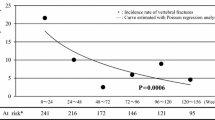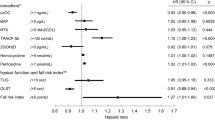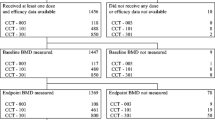Abstract
To demonstrate the clinical benefit of risedronate at 2.5 mg daily in the treatment of involutional osteoporosis, the effect of risedronate on incidence of vertebral fracture was compared with that of etidronate. A total of 547 patients with one to four vertebral fractures were randomized to receive either treatment with 2.5 mg/day of risedronate or intermittent treatment (treatment of 2 weeks and off period of 10 weeks) with 200 mg/day of etidronate for 96 weeks in a double-masked fashion. All patients received 200 mg calcium supplement daily. Lateral and anteroposterior thoracic and lumbar spine radiographs were obtained at baseline and at 24, 48, 72, and 96 weeks. Cumulative incidence rates of patients who had at least one new or worsening vertebral fracture during the 96-week period were 12.3% for risedronate and 14.2% for etidronate, and it was verified that the fracture prevention effect of risedronate was not inferior to that of etidronate. The incidence rates of fracture during the initial 24-week period were 8.8% for risedronate and 6.0% for etidronate, but the cumulative incidence rate of fracture from 24 to 96 weeks was lower in the risedronate group (3.9%) as compared to the etidronate group (8.7%). Height loss was significantly less in the risedronate group (−0.28 cm) than in the etidronate group (−0.70 cm) after 96 weeks. Decreases in bone resorption markers including urinary total deoxypyridinoline and NTX were significantly greater in the risedronate group than in the etidronate group throughout the treatment period. An improvement of patient QOL was observed in both groups. No significant difference in the incidence of adverse events was observed between the two treatments. Daily oral risedronate (2.5 mg) was shown to provide an effective therapy for involutional osteoporosis in Japanese patients with good tolerability.
Similar content being viewed by others
Author information
Authors and Affiliations
Consortia
Corresponding author
About this article
Cite this article
Kushida, K., Fukunaga, M., Kishimoto, H. et al. A comparison of incidences of vertebral fracture in Japanese patients with involutional osteoporosis treated with risedronate and etidronate: a randomized, double-masked trial. J Bone Miner Metab 22, 469–478 (2004). https://doi.org/10.1007/s00774-004-0509-z
Received:
Accepted:
Issue Date:
DOI: https://doi.org/10.1007/s00774-004-0509-z




